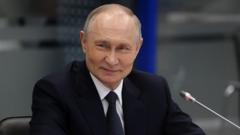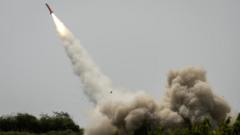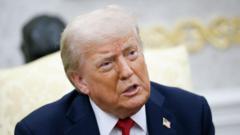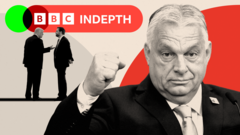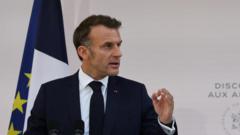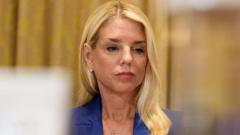President Trump declared a commitment to boost arms support for Ukraine during a NATO meeting, coupled with a warning of tariffs and sanctions against Russia. Meanwhile, Ukraine's President Zelensky considers significant government changes in response to ongoing military challenges.
Trump Proposes Increased U.S. Arms Support for Ukraine Amid Russian Aggression

Trump Proposes Increased U.S. Arms Support for Ukraine Amid Russian Aggression
In a bold move, President Trump announced plans to amplify military aid to Ukraine, but skepticism remains regarding the effectiveness of his threats toward Russia.
Article:
In a strategic pivot, President Trump unveiled yesterday a proposal to enhance military assistance for Ukraine, emphasizing the U.S. role in facilitating European arms supplies to strengthen Kyiv's defense against ongoing Russian assaults. During discussions with NATO Secretary General Mark Rutte, Trump underscored a timeline of 50 days, warning Russia of potential "very severe tariffs" if a peace agreement is not reached by then.
Although the effectiveness of such tariffs is questionable, given Russia's minimal trade relations with the U.S., Trump escalated the situation by suggesting secondary sanctions against nations that continue to engage with Russia. This stance bears similarities to his predecessor's policies of arming Ukraine while aiming for a resolution through economic pressure.
In further remarks, Trump expressed disappointment with Russian President Vladimir Putin, highlighting a discord between their personal interactions and Russia's aggressive military action: “My conversations with him are very pleasant, and then the missiles go off at night,” he noted. Analysts like David Sanger and Maggie Haberman express skepticism about Trump maintaining a consistent approach to aiding Ukraine.
Meanwhile, as the conflict continues to reveal deep challenges, Ukrainian President Volodymyr Zelensky announced intentions to shake up his cabinet, indicating a possible replacement for the current prime minister in response to recent battlefield difficulties and a growing somber sentiment among the populace. As tensions escalate, the international community watches closely for necessary responses.
In a strategic pivot, President Trump unveiled yesterday a proposal to enhance military assistance for Ukraine, emphasizing the U.S. role in facilitating European arms supplies to strengthen Kyiv's defense against ongoing Russian assaults. During discussions with NATO Secretary General Mark Rutte, Trump underscored a timeline of 50 days, warning Russia of potential "very severe tariffs" if a peace agreement is not reached by then.
Although the effectiveness of such tariffs is questionable, given Russia's minimal trade relations with the U.S., Trump escalated the situation by suggesting secondary sanctions against nations that continue to engage with Russia. This stance bears similarities to his predecessor's policies of arming Ukraine while aiming for a resolution through economic pressure.
In further remarks, Trump expressed disappointment with Russian President Vladimir Putin, highlighting a discord between their personal interactions and Russia's aggressive military action: “My conversations with him are very pleasant, and then the missiles go off at night,” he noted. Analysts like David Sanger and Maggie Haberman express skepticism about Trump maintaining a consistent approach to aiding Ukraine.
Meanwhile, as the conflict continues to reveal deep challenges, Ukrainian President Volodymyr Zelensky announced intentions to shake up his cabinet, indicating a possible replacement for the current prime minister in response to recent battlefield difficulties and a growing somber sentiment among the populace. As tensions escalate, the international community watches closely for necessary responses.



